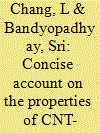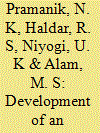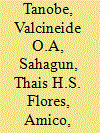|
|
|
Sort Order |
|
|
|
Items / Page
|
|
|
|
|
|
|
| Srl | Item |
| 1 |
ID:
130748


|
|
|
|
|
| Publication |
2014.
|
| Summary/Abstract |
Recently it has been reported in the technical literature that carbon nanotubes (CNTs) have distinct effects on thermal, mechanical and electric properties of epoxy resins. Compared to single-walled nanotubes (SWCNT), multiwalled nanotubes (MWCNT) apparently show greater improvements. The maximum aspect ratio (L/D) of CNT is reportedly as high as 138,000,000. In addition, the carbon nanotubes when treated with surface modifier to generate functional groups on their surface can afford to provide better improvement of the properties of the epoxy based CNT-particulate composite system. There are a number of factors that can influence the properties of epoxy-CNT systems. This paper examined the technical contents from selective references and made an attempt to highlight the general understanding of the properties and performance of epoxy - CNT particulate composite systems
|
|
|
|
|
|
|
|
|
|
|
|
|
|
|
|
| 2 |
ID:
130739


|
|
|
|
|
| Publication |
2014.
|
| Summary/Abstract |
When Nylon 66 was irradiated by an optimum dose of e-beam in presence of polyurethane as impact modifierin combination with triallyl is ocyanurate as cross-linker, a superior performance was observed for the irradiated nylon 66. Significant improvement of properties, such as hardness, tensile strength, flexural modulus and impact strength was obtained on radiation processing of nylon 66 by e-beam. More interestingly, percent water absorptionof such irradiated nylon 66 was reduced substantially. Improvement of mechanical properties and reduction of water absorption of irradiated nylon 66 were due to the cross-linking of the polymer system. Increase of cross-linkingwith dose of e-beam was verified by the increased gel content at higher doses. Irradiated nylon 66 showed betterdimensional stability than those achieved with pristine nylon 66. The increase in dimensional stability may beattributed to reduction in crystallinity with increasing dose of e-beam as revealed by DSC studies.
|
|
|
|
|
|
|
|
|
|
|
|
|
|
|
|
| 3 |
ID:
141889


|
|
|
|
|
| Summary/Abstract |
The efforts were made to improve the hot-pressing method of carbon/carbon (C/C) composite fabrication. The C/C composite was fabricated by hot-pressing the slurry moulded compact followed by carbonisation. The temperature and time shifts during hot-pressing were made in order to see their effect on the densification. Their effect was checked through visual inspection, density measurement, scanning electron microscope (SEM) analysis, and mechanical properties evaluation. The results showed that the temperature shift yielded in significant increase in the density after hot-pressing. Further, the density pick up instead of fall after carbonisation was noticed. The results further showed that the time shift too yielded in significant enhancement of density after hot-pressing and showed the pattern after carbonisation similar to the temperature shift. And also showed that the shifts of both temperature and time yielded in significant increase in density and moderate increase in mechanical properties.
|
|
|
|
|
|
|
|
|
|
|
|
|
|
|
|
| 4 |
ID:
130713


|
|
|
|
|
| Publication |
2014.
|
| Summary/Abstract |
There is an increasing demand for designing controlled drug delivery systems with materials which are morebiocompatible, economical and materials which can be processed easily. Poly (vinyl alcohol) (PVA) and hyaluronic acid (HA) are promising polymers for applications in drug delivery. PVA forms gel based on the acetal bridges when cross linked with glutar aldehyde (GA). On the other hand, HA a natural polymer, forms gel with divinyl sulfone(DVS) as a cross linker. PVA and HA blends upon crosslinking PVA with GA or HA with DVS, in the presence of the other polymer, form gels that are more adaptable to the drug delivery systems. In this work, the mechanical properties and swelling behaviour of PVAHA gels were characterized. The effect of composition on visco elasticmoduli and degree of swelling was determined. The storage modulus (G?) of various gels made of PVA, HA and PVAHA blends were measured using rheology and compared with the values available in the literature. Swelling properties were measured and compared among various PVA and HA gels. Collagen is added to PVA solution and the rheological properties were measured in the gel state. Based on the values of storage modulus, gels of various compositions of PVA, HA and collagen might be selected as potential biomaterials for drug delivery system depending on careful understanding the type of application.
|
|
|
|
|
|
|
|
|
|
|
|
|
|
|
|
| 5 |
ID:
141873


|
|
|
|
|
| Summary/Abstract |
The present study is concerned with laser beam welding of 15CDV6 steel, that is in the hardened (quenched and tempered) condition before welding. Autogenously butt-welded joints are made using carbon dioxide laser with a maximum output of 3.5 kw in the continuous wave mode. Weld microstructure, microhardness measurement across the weldment, transverse tensile properties, and room temperature impact properties of the weldment have been evaluated. The fusion zone exhibits a epitaxial grain growth. The microstrutural features of heat-affected zone and fusion zone vary, due to different thermal cycles for which these were subjected during welding. The average weld metal hardness was 480 Hv. The observed hardness distribution across the welds were correlated with the microstructures. The welds exhibited lower toughness of 50 joules as compared to parent metal of 55 joules and the tensile strength values of the welded specimens are close to that obtained for sheet specimens.
|
|
|
|
|
|
|
|
|
|
|
|
|
|
|
|
| 6 |
ID:
130737


|
|
|
|
|
| Publication |
2014.
|
| Summary/Abstract |
Increasing environmental concern along with the drive to find substitutes for synthetic fibers and value added applications for low cost and renewable plant fibers have led to the development of composites based on biomaterials. One of the drawbacks encountered in such exercise is the lack of adhesion between the incorporated plant fibers and synthetic polymeric matrices. Such drawback can be reduced by appropriate treatment of fibers. This paper describes the chemical treatments used on sponge gourd (Luffa cylindrica) fibers of Brazil to prepare their composites with polyester resin. Production of short fiber-polymer composite as well as mat-polyester composites is presented here. Characterization of the composites in respect of evaluation of density, water absorption, thermalstability, tensile properties and impact strength were made and the results are discussed. Observed impact strengthand tensile properties are discussed based on the fractographic studies of the composites.
|
|
|
|
|
|
|
|
|
|
|
|
|
|
|
|
| 7 |
ID:
130746


|
|
|
|
|
| Publication |
2014.
|
| Summary/Abstract |
It is believed that addition of small amount of nanoclays in the neat epoxy and fiber reinforced epoxy composite system can improve the mechanical properties. The mechanical properties of most of polymer matrix composites are sensitive to testing rate. However, most of the researches were concentrated on the behavior of the polymer
matrix composites at high strain rates. The present research work is to investigate the role of clay on neat epoxy and glass-fiber reinforced epoxy composites, at low strain rates. The clay in terms of 1.5 wt%, 3 wt%, and 5 wt% are dispersed in the epoxy resin using mechanical stirring followed by sonication process. The corresponding glass/epoxy nanocomposites are prepared by impregnating the clay epoxy mixture by hand lay-up process. Characterization of the nanoclay is done by X-ray diffraction and Scanning Electron Microscopy. Tensile stress-strain curves are obtained at strain rates of 10-4 s-1, 10-3 s-1, 10-2 s-1, and 10-1 s-1 by a hydraulic machine reporting that, even at low strain rates, the longitudinal strength and stiffness increase as strain rate increases for all clay loadings. It is observed that the tensile modulus increases as the clay loading increases for both epoxy and glass/epoxy nanocomposites. It is also noticed that the longitudinal tensile strength decreases as the clay loading increases. The failed specimens show marked changes in the fracture surface with increased strain rate. Scanning electron microscopy is used to study the fiber/matrix/clay adhesion in fracture surfaces.
|
|
|
|
|
|
|
|
|
|
|
|
|
|
|
|
|
|
|
|
|